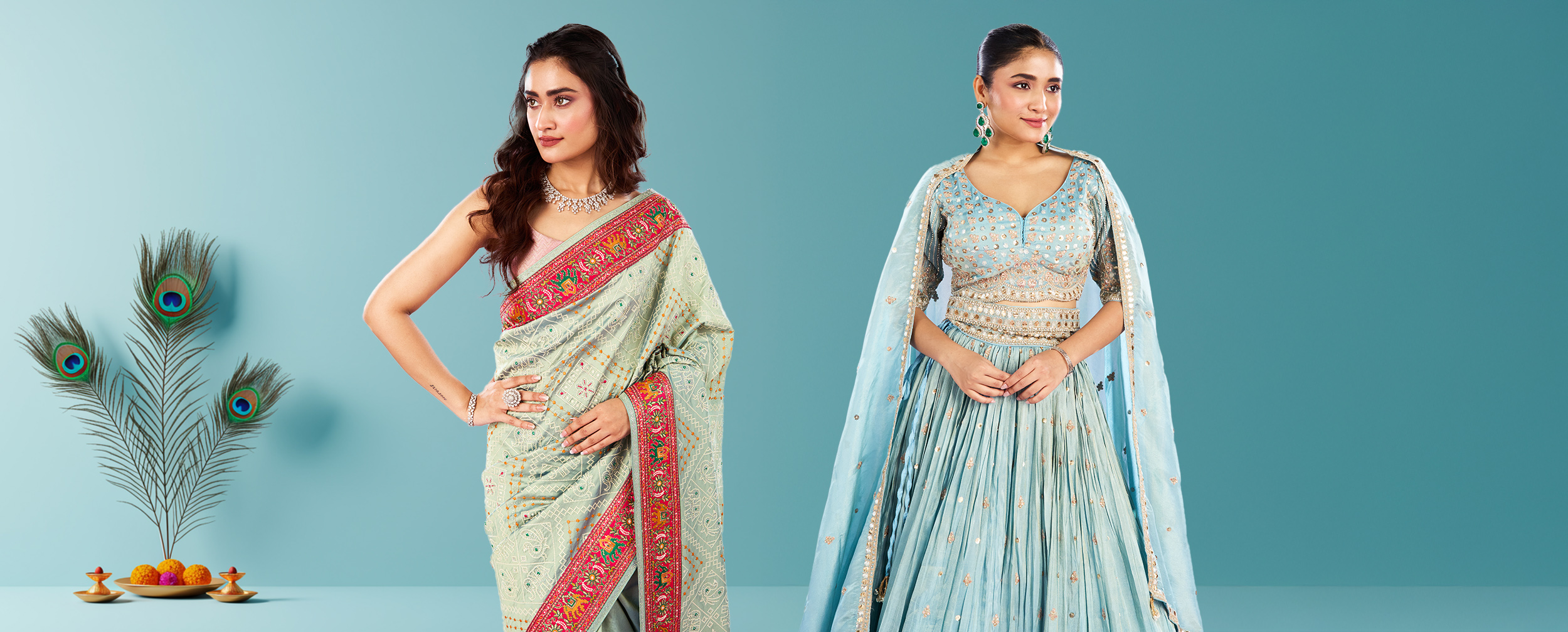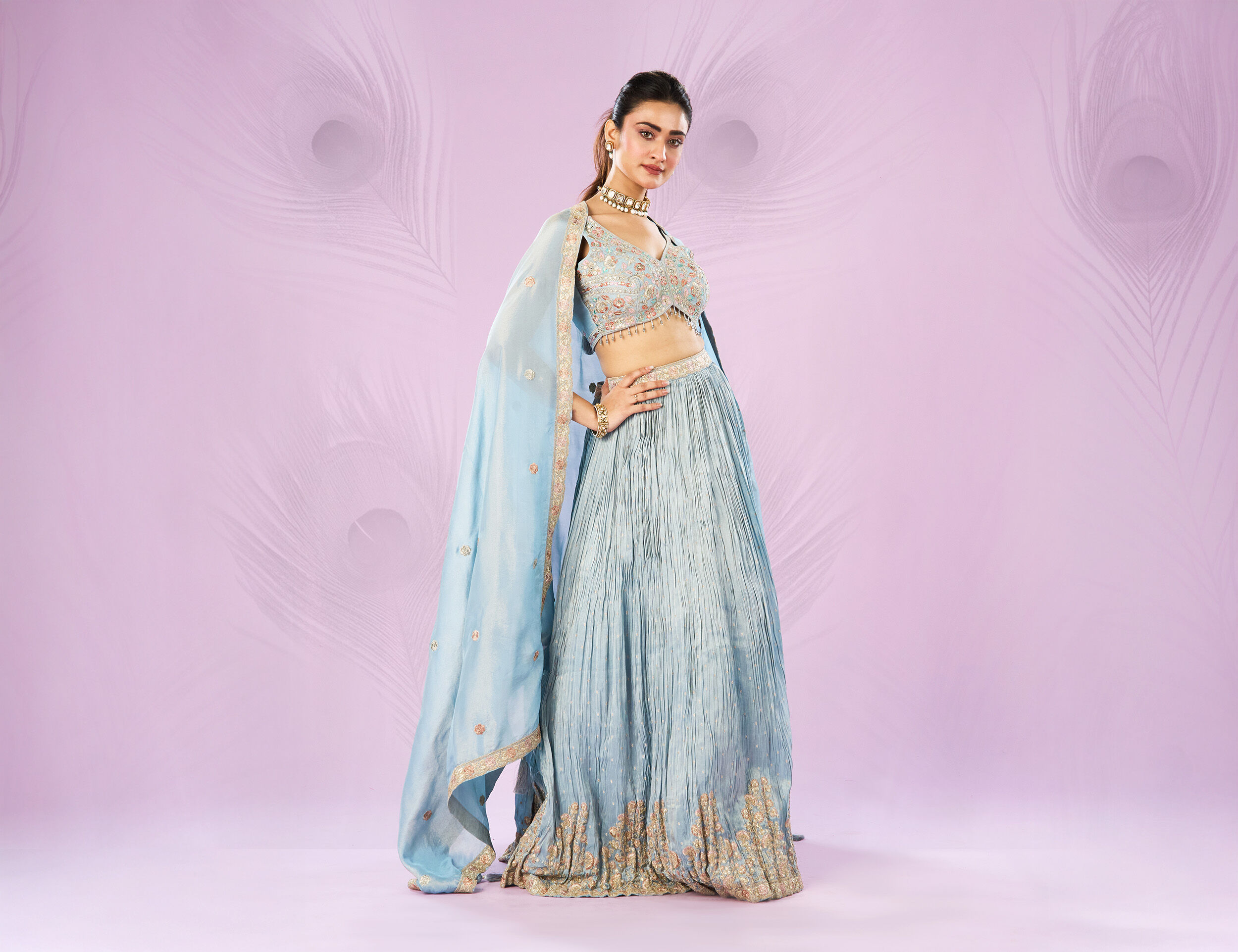STORIES BY MANYAVAR & MOHEY

Lifestyle
Why Is Janmashtami Celebrated: Religious and Cultural Significance
Date 26 July 2025 Reading time: 7-10 mins
The sweet sound of flutes, the joyous chants of "Hare Krishna," and homes adorned with tiny footprints – these sights and sounds mark the arrival of one of India's most beloved festivals. Have you ever wondered why is Janmashtami celebrated with such devotion across India?
As we prepare for Janmashtami, let's explore the deep-rooted significance behind this festival, understand why Krishna Janmashtami is celebrated with such enthusiasm, and discover how to dress appropriately for the occasion with Mohey's festive fashion guide.
What is Janmashtami?
Janmashtami, also known as Krishna Janmashtami or Gokulashtami, marks the birth anniversary of Lord Krishna, the eighth avatar of Lord Vishnu. This auspicious occasion falls during the Krishna Paksha (dark fortnight) of the month of Bhadrapada in the Hindu calendar, typically between August and September in the Gregorian calendar.
The festival's name itself tells its story – 'Janma' meaning birth and 'Ashtami' referring to the eighth day when Krishna was born. This is one of the reasons why Janmashtami is celebrated for two days in many regions of India.
Why is Janmashtami Celebrated?
Why Krishna Janmashtami is celebrated goes beyond merely commemorating a birth – it celebrates Krishna's role as a divine teacher, protector, and guide. His teachings in the Bhagavad Gita continue to provide spiritual wisdom and moral guidance to millions worldwide. The festival serves as a reminder of Krishna's message of devotion, righteousness, and courage in the face of adversity.
The celebration also symbolises the eternal bond between the divine and devotees, encouraging people to live by Krishna's principles of love, sacrifice, and dharma in their daily lives.
The History of Janmashtami
The historical roots of why Janmashtami is celebrated trace back thousands of years to ancient India. According to Hindu mythology, when adharma (unrighteousness) prevailed during the Dwapara Yuga, Lord Vishnu incarnated as Krishna to restore balance and dharma.
Born to Devaki and Vasudeva in Mathura, Krishna's birth story is filled with divine intervention and miracles. His father managed to smuggle the newborn Krishna across the Yamuna River to Gokul, where he was raised by his foster parents, Nanda and Yashoda.
The Significance of Janmashtami in Hinduism
In Hinduism, Janmashtami holds profound spiritual significance. Why is Janmashtami celebrated with such reverence? Because Krishna represents the perfect embodiment of divine love, wisdom, and action.
Janmashtami also fosters community bonding and cultural preservation, as people come together to celebrate regardless of regional, social, or economic differences.
How is Janmashtami Celebrated?
Janmashtami celebrations are as diverse as India itself, with each region adding its unique cultural flavours to the festivities. However, some common elements unite these celebrations across the country.
The most distinctive aspect explaining why Janmashtami is celebrated for 2 days is the timing of Krishna's birth. Since Krishna was born at midnight, the main celebrations typically begin in the late evening of the first day and continue into the early hours of the second day.
Key rituals include:
- Fasting throughout the day until midnight
- Singing devotional songs (bhajans) and chanting Krishna's names
- Decorating homes with tiny footprints, symbolising Krishna's entry
- Bathing and adorning Krishna idols with new clothes and ornaments
- Breaking the fast after the midnight birth celebration
- Reading scriptures about Krishna's life
Janmashtami Celebrations Across India
Understanding why Janmashtami is celebrated for two days also relates to the different aspects of celebration – the first day focuses on spiritual preparation through fasting and devotion, while the second day often includes more community-oriented festivities.
- In Mathura and Vrindavan: Temples are beautifully decorated, special abhishekams (ritual baths) are performed for deities, and devotional singing continues for days.
- In Maharashtra: "Dahi Handi" celebrations steal the spotlight.
- In Gujarat: Raas Leela performances are held, depicting Krishna's dance with the gopis.
- In Tamil Nadu and Kerala: Homes are decorated with kolams (rangoli) and footprints leading to the prayer room.
Janmashtami Celebrations Around the World
Why Krishna Janmashtami is celebrated extends beyond India's borders to various parts of the world where Hindu communities reside:
- In the United Kingdom: Temples organise grand processions, cultural programmes, and community feasts.
- In the United States: ISKCON (International Society for Krishna Consciousness) temples lead elaborate festivities including kirtan (devotional singing), lectures, and prasadam distribution.
- In Nepal: Janmashtami is an official holiday with thousands visiting Krishna temples, particularly the Krishna Mandir in Patan Durbar Square.
Unique Traditions of Janmashtami
Some fascinating and lesser-known traditions explain why Janmashtami is celebrated for two days with such diversity:
- Chappan Bhog: In some regions, devotees prepare 56 different food items (Chappan Bhog) as an offering to Lord Krishna, symbolising the 56 days he allegedly fasted during a particular episode in his life.
- Jhulanotsav: Prior to Janmashtami, some communities celebrate Jhulanotsav, where Krishna and Radha idols are placed on decorated swings and gently rocked while devotees sing songs.
- Krishna Abhishekam: In South Indian temples, the ritual bathing of Krishna idols with panchamrit (a mixture of milk, curd, ghee, honey, and sugar) is performed with grand ceremony.
- Shobha Yatras: Many cities organise grand processions featuring tableaux of Krishna's life events, accompanied by devotional music and dance performances.
What to Wear on Janmashtami: Festive Fashion Guide by Mohey
Dressing appropriately for Janmashtami celebrations adds to the festive spirit while honouring the cultural significance of the occasion. Mohey offers a wide range of women's festive wear that perfectly blends heritage with contemporary style, making it ideal for Janmashtami festivities.
Indian Attire for Women
For Janmashtami, women traditionally opt for outfits in colours associated with Lord Krishna - peacock blue, yellow, and purple being the most popular choices. Light cotton or silk sarees with Krishna-themed motifs or peacock designs work beautifully for temple visits and community celebrations. Lehengas and suit sets work better in bright, festive colours and are better for dance performances.
Lehengas Inspired by Radha-Krishna Themes
Lehengas make a striking choice for special Janmashtami events, especially those involving dance performances or evening celebrations. Mohey's lehenga collection offers beautiful options inspired by Radha-Krishna themes.
Why Krishna Janmashtami is celebrated with such artistic expression is reflected in the designs and motifs used in festive wear:
- Peacock-Inspired Designs: Lehengas featuring peacock feather motifs honour Krishna's crown and divine appearance
- Flute and Lotus Patterns: Outfits with subtle embroidery depicting Krishna's flute or lotus flowers capture the essence of his divine persona
- Radha-Krishna Colour Combinations: Yellow and blue combinations symbolise the divine couple, making them perfect for the occasion.
Sarees with Intricate Embroidery and Mythological Motifs
Sarees remain a timeless choice for Janmashtami celebrations, especially for married women and those attending temple ceremonies. When selecting a saree for this occasion, consider these aspects:
- Krishna-themed Borders: Sarees with borders depicting scenes from Krishna's life add a meaningful touch to your festive look
- Gopi Dot Patterns: Subtle dot patterns reminiscent of the gopis' foot movements during raas leela make for an interesting design element
- Mathura-Inspired Weaves: Sarees with weaving techniques authentic to Mathura and Vrindavan regions connect your outfit to Krishna's birthplace
Anarkalis and Indo-Western Gowns for a Graceful Look
For those seeking comfort without compromising on style, Anarkalis and Indo-Western gowns offer elegant alternatives. These flowing silhouettes are particularly suitable for evening Janmashtami celebrations and cultural performances.
Why Janmashtami is celebrated for 2 days often involves different types of gatherings, making versatile outfits necessary:
- Flared Anarkalis: Their circular cut makes them perfect for devotional dance performances
- Jacket-Style Gowns: These provide a regal look for special community gatherings while maintaining comfort
- Angrakha-Style Tops: These cross-over style tops paired with flowing skirts offer both tradition and ease of movement
Styling Tips for Janmashtami Celebrations
Creating the perfect Janmashtami look goes beyond just the outfit. Here are some comprehensive styling tips to complete your festive appearance:
Colours That Resonate with the Festive Spirit
- Peacock Blue: Representing Krishna's complexion and peacock feather crown
- Butter Yellow: Symbolising his love for butter and the golden flute
- Purple and Lavender: Representing royalty and spiritual awakening
- Fresh Green: Signifying the lush meadows of Vrindavan where Krishna played
Styling Tip: Combine two significant colours like blue and yellow in your outfit to create a balanced look that honours both Krishna and Radha.
Accessorising with Traditional Jewellery
- Peacock-Motif Jewellery: Earrings, necklaces, or maang tikas featuring peacock designs
- Silver Anklets with Ghungroos: Perfect for dance performances, these evoke the sound of Krishna's anklets.
- Flute-Shaped Pendants: A subtle nod to Krishna's divine instrument
- Temple Jewellery: South Indian temple jewellery with divine motifs adds an authentic touch.
Footwear and Hairstyling Ideas for the Occasion
Footwear Options:
- Comfortable juttis or mojaris for extended wear
- Simple Kolhapuri sandals that can be easily removed at temples
- Embroidered flats that complement your outfit without overshadowing it
Hairstyle Ideas:
- Braid adorned with fresh jasmine flowers or gajra
- Bun decorated with gajra and ornate hairpins
- Half-up style with a statement maang tika for a balanced look
- Loose waves adorned with small flowers for a youthful appearance
Styling Tip: Consider the practicality of your hairstyle based on the activities you'll participate in – secure styles work better for active celebrations, while elaborate styles may be suitable for more formal gatherings.
Immerse Yourself in Festivities
Understanding why is Janmashtami celebrated helps us appreciate its deeper significance beyond the festivities – it's a reminder of divine love, righteousness, and the eternal bond between the devotee and the divine.
As you prepare for Janmashtami celebrations, let your outfit reflect both the festive spirit and the profound meaning behind the occasion. Mohey's celebration wear offers the perfect blend of classic and contemporary style to help you look your festive best while honouring this special day.






